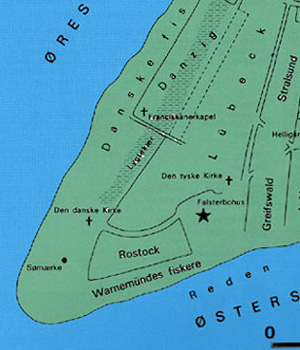| Skånemarkedet

| | Sildefiskeriet omkring Skanør-odden og det dertil knyttede Skånemarked udgør et vigtigt økonomisk center i Øresunds- og Østersøregionen.
For kongemagten betyder det en væsentlig indtægtskilde. I gode år i 1300-tallet blev der årligt produceret op til 300.000 tønder sild årligt. |
Selvom byudviklingen var beskeden set i forhold til hansestædernes vækst havde det danske rige dog afgjorte fordele af væksten i landbrugsproduktionen og sildefiskeriet, der om efteråret forgik langs Øresunds kyster. Især Skanør-fiskeriet og det dertil knyttede Skånemarked var af stor økonomisk betydning for den danske kongemagt. Skanør og Falsterbo var dog helt specielt ved sin tidsbegrænsede aktivitet, hvor fiskeriet foregik i efterårsmånederne og markedet knyttede sig hertil. I denne periode boede og arbejdede udlændinge og lokale på området.

Skånemarkedet | 
Sildefiskeri | 
Skanør kirke | 
Borganlæg |
Sildefiskeriets betydning
Allerede i 1000-tallet er der beretninger om store mængder af sild i Øresund, men først i katolsk tid med kødløse fredage og fastedage og nedsaltning med salt fra Lüneburger Heide bliver silden den vigtigste eksportvare. I gode år i 1300-tallet kunne der årligt produceres og eksporteres op til 300.000 tønder årligt og det anslås at omkring en tredjedel af den danske krones indtægter stammede fra indtægterne af skånemarkedet og det bliver da også det vigtigste marked i Øresunds- og Østersøregionen.
Hansaens interesser.
Hanseaternes magt over østersøhandelen aftager omkring år 1300. Allerede i 1250 havde de første ummelandsfarere, folk fra Nederlandene og England der sejlede ummeland, dvs. nord om Jylland og ned igennem Sundet for at komme ind i Østersøen, vist sig på Skånemarkedet. Hanseaterne anvender deres kontrol over Skånemarkedet i perioden 1368-85 til at udelukke omlandsfarerne, men disse kan nu med de mere veludviklede skibstyper sejle direkte til destinationer langt inde i Østersøen. Desuden finder hollænderne ud af at fiske sild i Nordsøen, således at man helt kan undvære Skånemarkedet. Hertil kommer endelig at sildefiskeriet i Sundet kulminerer hen imod slutningen af 1300-tallet. |